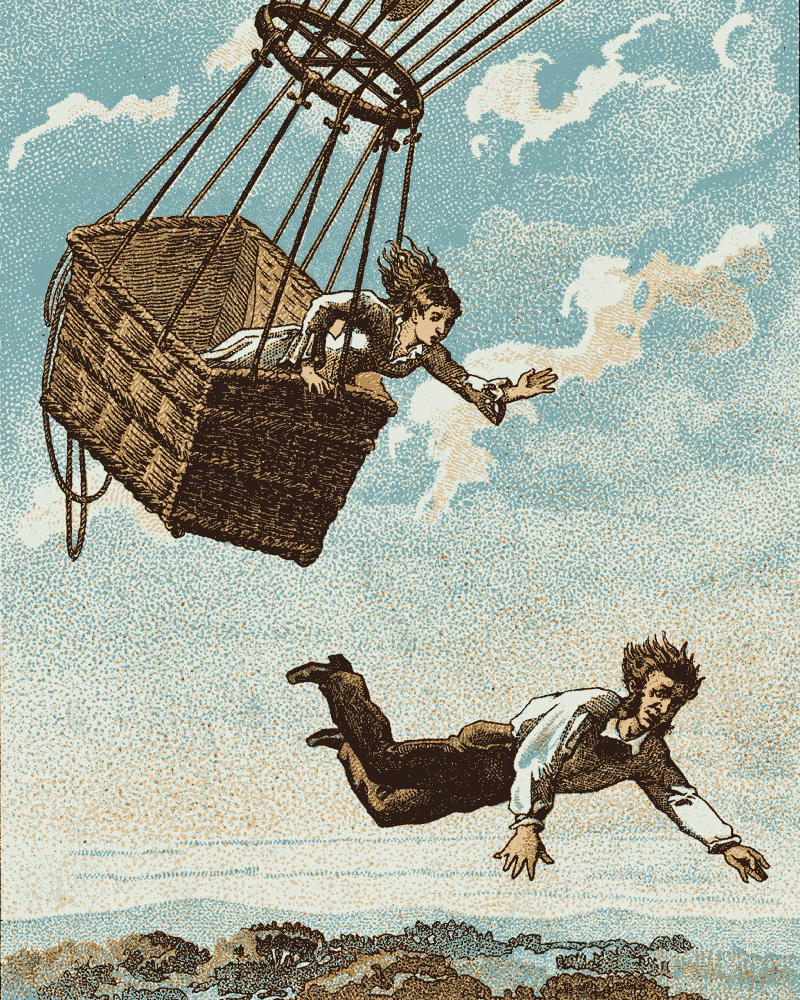The great falling damage debate of 1983-84

Rules for falling have plagued designers since the dawn of gaming. Here, falling damage is depicted in the prehistoric sci-fi role-playing game Papers & Paychecks. (Photo by Simon Palmer, CC-BY-SA 2.0)
In the old days of gaming—or, rather, perhaps the mid-days in the late seventies and early eighties, there were many strange controversies. Perhaps the strangest was the continuing debate over falling damage. We were willing to set up universal rules, simple rules, for handling all sorts of esoteric things in our games, but when it came to incredibly mundane tasks that we’re familiar with, we create complicated subsystems—or even remove the mundane tasks completely into their own system. Falling—and grappling1—are among the most blatant examples of these.
Falling damage is one of the strangest things in immediate post-old-school role-playing games. Games that let people survive huge fireballs of magical flame without a scratch target falling for special lethality. Games that let people survive nuclear explosions make falling 100% fatal. We argued about the realism of falling damage in the major magazine of the time. What’s the deal?
Dragon Magazine had a controversy that started in issue 69 with a brief note in Gary Gygax’s article on the Thief-Acrobat, that damage should be rolled for each ten feet fallen. The first ten feet, roll 1d6; the second ten feet, roll 2d6 (for a total of 3d6); the third ten feet, roll 3d6 (for a total of 6d6), and so on, so that damage rapidly builds up. In issue 70 Frank Mentzer expanded the new “interpretation” of the rules and explained how the original interpretation in the Players Handbook was the result of editors fixing a non-existent typo.
Scott Hoffrage wrote in to the letters column (issue 72) that both systems were wrong. If you measure the distance fallen, damage taken shouldn’t be a geometric or linear progression but a geometric regression. He then concluded that it would be easiest just to keep the original rules, even though they deal too much damage, because the new interpretation dealt far too much damage.
In issue 88, falling damage got on the cover. Arn Ashleigh Parker’s “Physics and falling damage” argued that velocity should be key. In this system, damage had to be looked up on a table: it was too complex for a simple system such as “1d6 per ten feet” or “1d6 per ten feet every ten feet”. It took six pages to explain.
In the same issue, Steven Winter argued in favor of kinetic energy. And lo, if you use kinetic energy, the correct system is linear, which brings you right back to the original 1d6 for every ten feet. He managed to explain it in one page.2
Seven pages on falling damage in one issue. Clearly this was important enough to keep out of the forum, which started in issue 81. But issue 90 was filled with responses in the forum.
I regret that you have relegated the fundamental rules governing the universe to a matter of opinion in the pages of DRAGON #88.
The controversy continued into the forums in issue 91, 92, and 93; issue 92’s letters page corrected the equations used in the velocity article. The controversy then skipped 94 but continued in 95 where a forum writer included the chance of broken bones in a table. From then I couldn’t find anything through issue 100, where I stopped looking.
On the one hand falling is something we do see happen in real life (as opposed to fireballs and nuclear explosions, knock on wood), but fictional characters certainly survive some amazing falls in our source material. Movies are notorious for their long survivable falls. Games that make falling lethal actually go against their source material most of the time.
I’ve already talked about Villains and Vigilantes with its tens of thousands of points of falling damage: they have a generic system already in place that handles impacts just fine, but made a special, complicated one for falling that deals more damage than nuclear blasts.
My solution for V&V was to do the same thing I did in Men and Supermen: create a class of inescapable damage (Massive Body Attack in M&S) and then let such damage partially bypass luck and skill, and go straight to injuries.
Maybe it’s because we actually see falling damage every once in a while on the news, or because we know it’s something that can easily happen to us. Or maybe its something we have a natural fear of. But falling damage is no more complex than any other damage, and we simplify for almost everything else. People can be injured in a 1-foot drop; they can survive hundred-foot drops. In other words, the perfect thing for a simple die roll, just like weapons.
AD&D’s Dungeon Masters Guide had special rules for grappling, and just like for falling Dragon occasionally ran articles on alternate systems. Yet, the only aspect of falling or grappling that doesn’t apply to normal weapons is that there’s an expectation of secondary effects granting an immediate benefit. Grappling lets you immobilize an opponent, for example. However, these effects are usually shared by other weapons: lassos let you immobilize an opponent; some polearms disarm an opponent; other polearms let you dismount them. It’s handled without even a simple saving roll. You hit, you disarm.
Lassos weren’t even in the original AD&D books. It was just assumed you would deal with it simply. They officially appeared in the Unearthed Arcana supplement3, where they allow a saving roll to avoid being caught, or to escape if caught, the rules allow either interpretation.
Why is grappling more complex than a lasso? I suspect it’s because most of us have grappled at least once in our lives, and have imagination enough to come up with complex imaginary moves that help us win. But really, none of this should be any more complex than weapons (for punches) or nets/lassos (for immobilization).
We used to make fun of these things in college, and for that reason I’m very sensitive to specialized subsystems for rarely-used events. In Gods & Monsters, falling is a simple contest, and immobilizing an opponent is an attack roll followed by a reaction roll. It’s most likely what you’d come up with on your own if the players in our group had never attempted such things. I don’t even have lassos, because despite Highland being an amalgam of fantasy medieval and the old west, the lasso has never come up as an option. If it did, it would be handled like anything else: the attacker needs to make a called shot, and the target gets to make an Evasion roll.
- February 6, 2018: The Great Falling War, Revisited
-

“Whatever happens, I’ll send the results to Dragon Magazine!”
Delta’s D&D Hotspot claims to focus on “Math, History, and Design of Old-School D&D”, so it isn’t surprising that Delta has revisited the great falling war of 1983-84.
What is surprising is the data that Delta provides. After a lengthy analysis of the participants in the war, Delta adds:
The real-world statistics of falling mortality are expressed in terms of “median lethal distance” (LD50), that is, the distance at which a fall will kill 50% of victims (who are presumably normal adults). Smith, Trauma Anesthesia, p. 3, asserts that LD50 is around 50 feet (4 stories). Wikipedia asserts that LD50 for children is at a similar height; 40-50 feet. Dickinson, et. al., in “Falls From Height: Injury and Mortality” (Journal of the Royal Army Medical Corps, 2013) notes that LD50 varies greatly by injury type: about [34 feet] for those who land on their head or chest; about [73 feet] for those who do not.
Fifty feet is a long way, and I don’t think I would have ever guessed that the mortality rate was only 50% falling that distance. Asked to guess, I’d probably have said 75% to 85% at least. This may be yet another case where real life is allowed to be stranger than fiction. Even more amazing is how much of a difference knowing how to fall makes: raising the LD50 to seventy feet just by falling better sounds like movie reality.
Of course, even not dying there’s likely to be a lot of injuries involved—although seeing the LD50 numbers does make me wonder what the serious injury rate is, and whether I’ve been overestimating that, too—and Gods & Monsters, unlike OD&D has a system for that. As Leland J. Tankersley writes in the comments,
I think the fundamental problem in reconciling reality with D&D-like games is that health in D&D is in some respects binary—you are either dead or effectively so (0 hp or less), or else you are “fine” (1 or more hp, which might be “near-death” in some sense but which doesn’t impair your ability to act in any way. While LD50 may be 50' for a typical human, I feel confident in asserting without evidence that the vast majority of those that are NOT killed by a 50' fall are nevertheless incapacitated (broken/shattered legs, for example).
Thanks to cibet in the Grognardia comments for reminding me about brawling systems.
“It’s not just falling damage that does this. Grappling is the same. Hit a moving and dangerous target with a flail or pole arm? No problem just roll a single dice. Want to punch someone or try to grab them? Oh boy, break out the intricate and byzantine grappling rules.”
↑In Men & Supermen I used impact. This meant falling damage was proportional to the square root of the distance fallen. “Fortunately” Men & Supermen already had a “square chart” that could be used to look up distance to damage and get a square root pattern.
↑Which also introduced new grappling rules to supercede the original in the Dungeon Masters Guide. These grappling rules have two levels of complexity: a quick version and a more complex version that builds on the quick version that “has greater detail and is the more powerful of the two”.
↑
- The Articles of Dragon: “Falling Damage”: James Maliszewski at Grognardia
- “Issue #70 of Dragon (February 1983) saw the appearance of ‘Falling Damage’ by Frank Mentzer, the first of what would turn into several articles discussing this strangely contentious subject.”
- Villains and Vigilantes falling damage off the charts
- Can someone explain Villains and Vigilantes falling damage? I can’t be reading it correctly. Falling speed seems to make sense. It is calculated per turn rather than per second, which makes things easier to calculate at heights lower than 500 feet, but that’s a decent abstraction.
More falling
- The Great Falling War, Revisited
- Delta’s D&D Hotspot revisits the falling wars, and provides a surprising bit of information about the lethality of falling.
- Villains and Vigilantes falling damage off the charts
- Can someone explain Villains and Vigilantes falling damage? I can’t be reading it correctly. Falling speed seems to make sense. It is calculated per turn rather than per second, which makes things easier to calculate at heights lower than 500 feet, but that’s a decent abstraction.
- Lifting and falling
- Falling is easy; lifting is hard.
